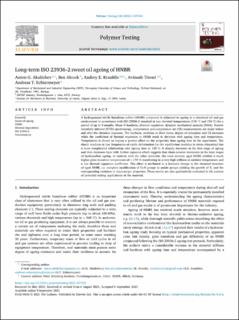| dc.contributor.author | Akulichev, Anton | |
| dc.contributor.author | Alcock, Benjamin | |
| dc.contributor.author | Krauklis, Andrey | |
| dc.contributor.author | Tiwari, Avinash | |
| dc.contributor.author | Echtermeyer, Andreas | |
| dc.date.accessioned | 2022-02-04T08:42:36Z | |
| dc.date.available | 2022-02-04T08:42:36Z | |
| dc.date.created | 2021-09-27T09:23:06Z | |
| dc.date.issued | 2021 | |
| dc.identifier.citation | Polymer testing. 2021, 102 1-9. | en_US |
| dc.identifier.issn | 0142-9418 | |
| dc.identifier.uri | https://hdl.handle.net/11250/2977060 | |
| dc.description.abstract | A hydrogenated nitrile butadiene rubber (HNBR) compound is subjected to ageing in a simulated oil and gas environment in accordance with ISO 23936-2 standard at two elevated temperatures (130 °C and 150 °C) for a period of up to 9 months. Shore D hardness, thermal expansion, dynamic mechanical analysis (DMA), Fourier transform infrared (FTIR) spectroscopy, compression and compression set (CS) measurements are made before and after the chemical exposure. The hardness, modulus at short times, degree of relaxation and CS increases while the coefficient of thermal expansion in HNBR tends to decrease with ageing time and temperature. Temperature is shown to impose a greater effect on the properties than ageing time in the experiment. The elastic modulus at low frequencies of cyclic deformation (or the equilibrium modulus in stress relaxation) has a more complicated relationship with ageing time at 150 °C. It sharply increases in the first stage of ageing and then decreases later with further exposure which suggests that chain scission dominates in the later stages of hydrocarbon ageing. In contrast with the other materials, the most severely aged HNBR exhibits a much higher glass transition temperature of +70 °C manifesting in a very high stiffness at ambient temperature and a low thermal expansion coefficient. This effect is attributed to a dramatic change in the chemical structure of aged HNBR, i.e. complete modification of C≡N groups to amide groups yielding the growth of Tg and the corresponding variation in macroscopic properties. These results are also qualitatively evaluated in the context of potential sealing applications of the material. | en_US |
| dc.language.iso | eng | en_US |
| dc.publisher | Elsevier | en_US |
| dc.rights | Navngivelse 4.0 Internasjonal | * |
| dc.rights.uri | http://creativecommons.org/licenses/by/4.0/deed.no | * |
| dc.subject | Viscoelasticity | en_US |
| dc.subject | ISO 23936-2 | en_US |
| dc.subject | Material degradation | en_US |
| dc.subject | HNBR | en_US |
| dc.subject | Sweet oil ageing | en_US |
| dc.title | Long-term ISO 23936-2 sweet oil ageing of HNBR | en_US |
| dc.type | Peer reviewed | en_US |
| dc.type | Journal article | en_US |
| dc.description.version | publishedVersion | en_US |
| dc.rights.holder | © 2021 The Authors. Published by Elsevier Ltd. | en_US |
| dc.subject.nsi | VDP::Plast- og komposittmaterialer: 523 | en_US |
| dc.subject.nsi | VDP::Polymer and plastics: 523 | en_US |
| dc.source.pagenumber | 1-9 | en_US |
| dc.source.volume | 102 | en_US |
| dc.source.journal | Polymer testing | en_US |
| dc.identifier.doi | 10.1016/j.polymertesting.2021.107343 | |
| dc.identifier.cristin | 1938738 | |
| dc.relation.project | Norges forskningsråd: 234115 | en_US |
| dc.relation.project | EU/Nr.1.1.1.2/VIAA/4/20/606 | en_US |
| dc.source.articlenumber | 107343 | en_US |
| cristin.ispublished | true | |
| cristin.fulltext | original | |
| cristin.qualitycode | 1 | |

